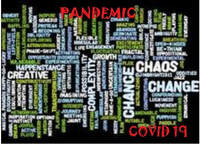
If you were caught off guard by the Coronavirus and your company disaster plan didn't include how to deal with a health pandemic, you were not alone. Even emergency preparedness agencies worldwide were not prepared for a disaster of the magnitude of the Coronavirus.
However it's never too late to revisit and revise your disaster plan or, if you don't have one, develop a plan.
In 2017 "Be Red Cross Ready with Disaster Planning" was written to remind rep firms to develop a disaster plan if they didn't already have one. Although the business disasters discussed did not include a health pandemic, the basic steps for planning are still valid.
When starting your plan, identify each type of disaster you could face. One plan does not fit all disasters. Make sure your written plan is clear and concise so everyone knows what is expected of them before, during, and after disaster strikes.
1. Plan - figure out what you need to have in place in order for your business to be ready to survive
- Ask yourself some questions -
- will we need to shut down during the crisis?
- will we need to furlough or eliminate personnel because of the disaster?
- how will we meet payroll?
- will we need to relocate the business or employees during the emergency?
- will our employees need to learn new skills in order to meet our customer's needs?
- how will we protect and access our data during the crisis?
- how will we share information during and after the disaster?
- what does recovery look like?
- Answer each question including multiple scenarios for each question asked, e.g. -
- A. if we are forced to shut down (for "x" number of days) we will continue to pay all employees
- B. if we are forced to shut down (after "x" number of days) we will have to eliminate/furlough employee A, B, and/or C
- C. if we are forced to shut down (after "x" number of days) we will have to eliminate/furlough all employees
2. Prepare - know what you need to do before and how to act during the emergency
- Gather resources in order to be ready for unexpected occurrences
- Stock needed equipment to meet government regulations
- Share plans and steps needed
- include clear steps for each employee so they know exactly what is expected of them
- Train employees on their new responsibilities
- Train employees to use current and new technology
- Be specific and honest with everyone concerned so they will know what they are facing
- explain, in detail, how communication will take place during the emergency
- reassure everyone that you will continue to monitor the situation
- be positive and realistic when discussing the results of the business disaster
3. Action - once the disaster has occurred know what to do to survive and recover
- Be flexible and ready to adapt to the changes that are taking place
- Keep everyone informed
- share information, let everyone know how and where to find answers
- listen to, and include your employees in discussions on the future of the business
Once the disaster is over, re-exam your plan and make any necessary changes from the lessons learned during and after the crisis.
Here's a couple of resources you can use to develop or revise your disaster plan:
Ready.gov
Red Cross - Types of disasters
As we found out, the lack of a good plan leads to chaos. Small businesses are especially vulnerable. Don't wait, now is the time to develop a plan and prepare your employees for any emergency.

 RSS Feed
RSS Feed